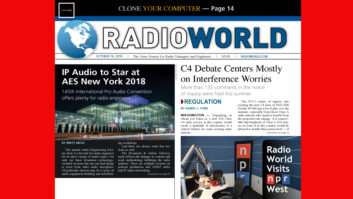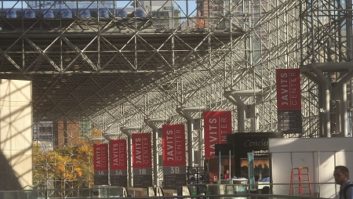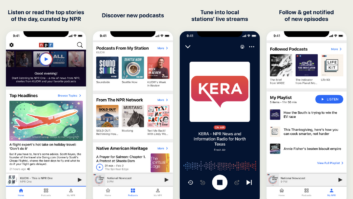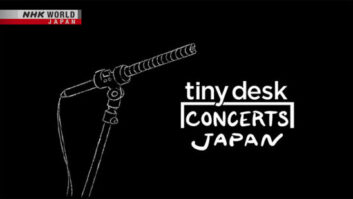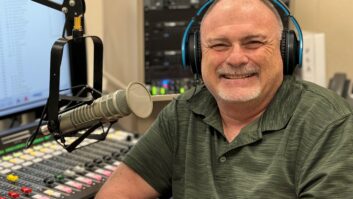NPR is a nearly ubiquitous programming source for public radio stations around the United States and the most well-known. It also has a well-deserved reputation amongst radio professionals as a standard bearer: Its systems are designed and built with an overarching plan using state-of-the-art technology. If you listen to “Morning Edition,” then you’ve likely heard “… and this is David Greene, in Culver City, Calif.” To go to that source, we’ll look at NPR West, its flagship in Culver City.

SOME HISTORICAL BACKGROUND
After President Lyndon Johnson signed the Public Broadcasting Act in 1967, the Corporation for Public Broadcasting was created, and Congress called upon it to encourage “the growth and development of noncommercial radio” and to develop “programming that will be responsive to the interests of the people,” according to NPR’s own history notes. The CPB introduced technical and professional standards to improve what were then mainly small stations, and soon the CPB and individual stations saw the need for a national radio service to bring Johnson’s vision to life.
NPR was incorporated on Feb. 26, 1970, by 90 charter stations, to provide national news programming. In April 1971, NPR took to the air with live coverage of the Senate hearings on the war in Vietnam; a month later it debuted its first weekday newsmagazine, “All Things Considered.” “Morning Edition” launched in 1979, “signaling that the network was becoming an all-day news service.”
In researching this article, I had the pleasure of speaking to several members of the technical staff of NPR, including Shawn Fox, senior director of audio engineering for NPR.
“Up until the year 2000 or so, National Public Radio had all of its eggs in only one basket, and that was our headquarters facility,” said Fox, referring to its Washington base. “We had small, little locations — just single studios in New York and a small bureau in Los Angeles and a small bureau in Chicago. And at that time, what we realized was those were just basic one-studio production facilities and that we needed a much larger presence on the West Coast.”

Concurrently, NPR management decided that their overall technical plant needed a robust disaster recovery site, as well as the ability to generate and disseminate original programming from California.
The Sept. 11, 2001 tragedy was a catalyst that made NPR complete their plans.
“We knew that being in the Washington, D.C. region and having no robust disaster recovery facility really put our listeners and our member stations at risk,” said Fox. “And that was really brought home because on 9/11, from the roof of our building, we could see the smoke rising from the Pentagon, and at the time, as we now know, the other plane that went down in Pennsylvania was headed to the Capitol and our facility was less than a mile away from there.”
THE ORIGINAL FACILITY
The building chosen to house NPR West has some interesting history of its own.
Desilu Productions’ studios produced many of the television shows that babyboomers remember fondly — including “Star Trek” and “Mission: Impossible.” The building in Culver City that houses NPR West once served as prop storage and, after Desilu moved on, was used by a furniture manufacturer.
“This city is fond of having a building show its heritage,” said Norb Gallery, the production manager for NPR West, when I asked about the remnant sheet-metal chimneys that still exist along the building walls outdoors. “And previous to our ownership, it was a company called Digital Planet, which was a video web content company.”

Fox told me NPR Engineering went through the design-and-build process and opened NPR West in November 2002, just in time for the election.
“The platform that we used specifically on the audio production side was Klotz. They were an emerging technology — an emerging digital technology that gave us a lot the flexibility that we were looking for.”
NPR WEST GETS A REFRESH
About a dozen years later the broadcast plant at NPR West was showing signs of age and was in need of an update. “Over the course of many years Klotz’s market share had decreased, and it was a bit more difficult to get support,” said Fox. “As we were projecting out, we saw that we were getting to end of life. We were seeing maintenance issues and it was time for a complete refresh. The technology had changed. Our workflows had changed.”
In 2013, NPR completed a complete rebuild and move of its Washington headquarters. “Obviously a much larger facility, but we had gone through a very detailed selection process on what platform we were going to use here in D.C. with a whole bunch of requirements,” Fox said.
Ultimately, the digital audio network/production system for the headquarters was built around equipment from Lawo; when it came time to rebuild Culver City, the choice in router systems was the same.
“When we got to California, one of our core requirements was that we could do a better job here in D.C. supplementing our L.A. staff in terms of support, in terms of the technology, as opposed to having competing platforms out there. It just made a lot of sense to be able to stay on the same platform across the entire organization, and across all facilities,” said Fox.

NPR Engineering wanted to make sure that it had a system that was expandable, to accommodate growth at NPR West; and it wanted to make sure that its content producers, if they happened to move from Washington to Los Angeles or vice-versa, would already be familiar with equipment.
“Content producers wouldn’t have to learn a different system. They wouldn’t have to learn a different technology. They wouldn’t have to learn a different platform. So by making it very similar to what we had already built out here in D.C., we were able to achieve those goals,” said Fox. “And of course, disaster recovery was always there and always in the background, and we always try to build in at least a 10 to 15 percent future expansion where disaster recovery might fit in.”
THE LAWO SYSTEM AT NPR WEST
The heart of the NPR West system is a fully-redundant Lawo Nova 73 router and DSP engine. “All the audio flows through here and almost every single path is redundant,” said Herbert Lemcke, president of Lawo North America, whom I met on-site in Culver City. “There is no single point of failure in the whole infrastructure down to a four-channel I/O card.”
The studio facility of NPR West consists of several large talk studio and control room combinations; smaller studios used for various production functions; smaller rooms used for light duty production functions; and the MOPS area, which oversees the operation of the plant.
In addition to Studios B and C, which are the larger control room/talk studio combinations, the studio complex includes the SOPS (self-operated) complex, which consists of four rooms.
“It’s basically two self-op control rooms, and two self-op studios,” said Lemcke. “They can work in a number of setups: The simplest one is four independent studios, each of which has an eight-fader crystal control surface. Then there are many use cases in which the inside room becomes the control room and the outside becomes the studio. There is also a use case where the two control rooms on the inside work together and are connected together where one becomes the studio, a complete studio space, to the other control room. There are four or five different combined modes of those four rooms together. In Washington, there are five of these complexes, and here we have one of them. But from its functionality, it’s the same.”

Another key area of interest in NPR is the MOPS location, which is a centralized monitoring point for everything that is going on in the facility. “The MOPS area is designed with the same functionality and the same layout and workflows as in Washington,” Lemcke told me. “Under normal circumstances this is a production facility tightly integrated with the Washington production facility for co-productions and remote productions. It also serves as a complete disaster recovery facility where, within half a day basically, all the co-production can be completely moved over to this facility [from Washington].
“In the MOPS area, we also have a couple of consoles and that is a little bit unusual. They are mainly used to assist those personnel in the five small productions ‘booths’ that are here, so that if somebody just doesn’t have the right skillset to work something directly themselves — or they need help — these consoles can basically take over the functionality of the console in the room and it can be completely remoted from here,” he said.
Referring to the MOPS monitor photo: The large middle screen shows up to 24 of 48 busses, which allow staff to look at program streams that are produced by NPR and distributed to the member stations. “It’s the visual interface to an automatic monitoring facility and it has a control system underlying to react on failure,” said Lemcke. “So for example, it shows you here some channels in red. There is signal failure — there’s silence. A silence alarm then can trigger many automated reactions such as the activation a redundant playout machine.

“On the bottom right side we have a monitor for the automation system, the line scheduler which is managing all the routing — all the timed, scheduled routing and lots of the individual one-off set ups, plus management of all the codecs, and playout machines. That’s the heart of the system,” Lemcke elaborated.
SIGNAL DISTRIBUTION
Currently, NPR West sends and receives program audio via to Washington and elsewhere making use of a large number of MUSICAM Prima LT codecs. However, that means of communication is soon to change. Shawn Fox explained another reason to use Lawo in Culver City was so that the two ends could send linear audio back and forth via AoIP, since the system supports use the Ravenna protocol.
“We knew our lives would be a lot easier and we could transition AoIP.” Speaking to us in July, he said the team hoped to transition by the end of the year, if not sooner.
I asked about the bandwidth requirement for the Culver City to Washington connection in the updated system. “We have 500 Mbps at the moment, It’s probably going to have to go a little bit higher than that,” said Norb Gallery.
“Depending on bandwidth, we might expand it even to support a ‘dash 7,’ seamless protection switching, so following the SMPTE 2022-7 standard,” said Lemcke. “That’s a little bit down the road, but that would give, basically, resilience in the network infrastructure against individual packet loss that might occur along the way from LA to Washington.”
I also noted a satellite uplink dish on the roof of NPR West and asked Fox about it. “There’s a long history with that satellite dish,” said Fox. “Because we knew we needed to strengthen the disaster recovery functionality, we had to be able to uplink from Culver City. We do use the downlink functions to record a lot of our programming and do a lot of monitoring, but the uplink side of it is there just for disaster recovery.

“If Washington was a smoking hole in the ground and the PRSS’ network operation center went down they have a robust backup facility in Saint Paul, Minn. — but we still would be dead in the water. We needed to be able to uplink,” said Fox.
NPR West staff test the uplink once per month, making sure it’s operational all the time, and programming is always routed to it. “If I have to call in the middle of the night to my guys in California and say ‘flip the switch,’ they can do that and get us up on the air.”
CULVER CITY PLAYS ITS ROLE
“Culver City has been a great partner for NPR West — I want to stress that,” said Fox. “We probably wouldn’t have been so successful in that location all these years if it was not for Culver City. They wanted to make sure that Culver City was represented somewhere on our airways — so when you actually listen to some of our programming, especially on ‘Morning Edition,’ we like to say ‘from Culver City.’ If we have David Greene there, we want people to know we are in California. We far exceed their requirements,” Fox said.
Coming next: American General Media in Bakersfield, Calif., rebuilds after a fire.
Radio World is looking for recent technical facilities and projects to feature. Email [email protected].






